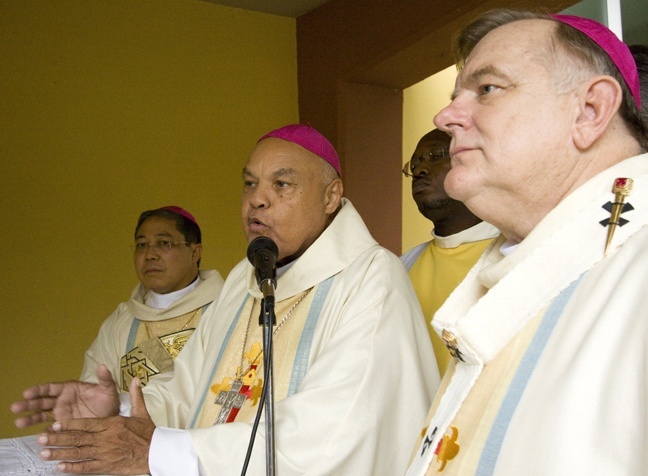By Ana Rodriguez Soto - Florida Catholic newspaper
MIAMI — The phrase “wounded healers” certainly applies to the Catholic Church in Haiti. It is struggling to meet the humanitarian needs of its people — both physical and spiritual — while working out of damaged or destroyed parishes, schools and clinics.
So far, most of the money collected by Catholic churches around the world for Haiti relief — about $304 million — has been put to use to provide food, water, shelter, jobs and medical care to the hundreds of thousands of Haitians who were injured and displaced by the Jan. 12 earthquake.
While that work will continue, Haiti’s Church soon will get some aid of its own, as some of that donated money will begin to be spent on rebuilding the facilities of the Church itself.
To do so in an “efficient and transparent” way, Haiti’s bishops met in Miami Sept. 22-26 with bishops from the United States, Canada, Argentina, Colombia, Mexico, Guadeloupe, Dominican Republic, El Salvador, France and Germany, as well as representatives of the Holy See, Catholic relief organizations and the Inter-American Development Bank. During this historic meeting, the bishops agreed to put in place a structure that will oversee how the work of reconstruction is carried out.
Known by the acronym PROCHE — which stands in both Creole and English for Partnership for Reconstruction of the Church in Haiti — it will consist of a joint steering committee chaired by the president of the Haitian bishops’ conference and composed of representatives of the Holy See, the Haitian bishops, religious orders working in Haiti and donor dioceses and agencies.
Under them will be a reconstruction unit, described as “like a back office, a construction office” by Archbishop Thomas Wenski during a press conference Sept. 24 at Notre Dame d’Haiti Church in Miami. Staffed by competent lay people with experience in engineering and architecture, the office will be responsible for drafting and approving reconstruction plans, and ensuring that all Church buildings adhere to safety and structural codes.
This structure will allow Haiti’s bishops, in partnership with donors from around the world, to make sure that the reconstruction work is done “in a most efficient but also in a most transparent way,” Archbishop Wenski said.
“This will give us confidence that the reconstruction process will go smoothly,” said Archbishop Bernardito Auza, papal nuncio to Haiti.
He noted that, so far, almost all of the funds collected for Haiti relief “have been employed in the humanitarian cause.”
In the meantime, the Haitian Church “is doing what it can with temporary structures,” said Richard Balmadier, who helped draft the PROCHE plan. He currently serves as special assistant for Haiti for Catholic Relief Services, the U.S. bishops’ international relief agency.
In addition to losing its archbishop, vicar general and chancellor, who were among the more than 230,000 people killed by the earthquake, the Archdiocese of Port-au-Prince lost 27 parish structures, and 11 more were heavily damaged. The national cathedral and national seminary also were destroyed. Parishes and other Church facilities in the dioceses of Jacmel and Anse-à-Veau et Miragoâne also were damaged or destroyed, along with buildings and seminaries belonging to religious orders.
“These are permanent structures that provide a tremendous amount of support in terms of spiritual and community services,” Balmadier said. “It’s a very important role that the Church plays.”
“We have to get people back to normal. This is one aspect of bringing Haiti back to normal,” added Balmadier, who described the meeting in Miami as “an expression of the level of support and genuine solidarity that exists throughout the global Church for the Church in Haiti.”
“I’ve never been at a meeting like this. It’s very exciting,” Balmadier said.
According to Oblate Missionary Father Andrew Small, who works in the U.S. bishops’ Office of National Collections, the American Church has set aside approximately $32 million for Church reconstruction projects in Haiti. That represents about 40 percent of the $82 million donated for Haiti during the special collection held in all U.S. parishes the weekend after the earthquake.
Another $68 million was donated directly to Catholic Relief Services, which means nearly half of the worldwide total collected for Haiti was raised by the Catholic Church in the United States.
“The money is still coming in,” Father Small said. “What we’re trying to figure out is how to spend it well.”
Archbishop Wenski, a member of the U.S. bishops’ Haiti advisory group who visited Haiti as recently as July, said he hoped the assurance of “efficiency and transparency” in how the money is spent will “inspire more generosity.”
“This is still just the beginning,” he said. “This effort will not be resolved by $30 million or $100 million and it’s not going to be resolved in one year or three years.”
“We are constantly edified by the hope of the Haitian people,” he added, who along with their bishops, priests and religious, continue to face “incredible difficulties.”
After the press conference, all of Haiti’s bishops and their international counterparts celebrated Mass at Notre Dame d’Haiti. The meeting concluded Sept. 26 with a Mass at St. John Vianney College Seminary.
To read Archbishop Wenski’s opening remarks at the Sept. 22-26 meeting, click here.
To read Archbishop Wenski’s homily at the closing Mass, click here.

Photographer: ANA RODRIGUEZ-SOTO | FC
Archbishop Louis Kébreau of Cap-Haitien, president of the Haitian bishops conference, speaks as Archbishop Thomas Wenski listens at a press conference prior to Mass at Notre Dame d'Haiti Sept. 24. Behind them is Archbishop Bernardito Auza, papal nuncio to Haiti.

